

| Home | For sale | Site map | Contact information | Guest book | Stielhandgranate 24 menu |
 Nebelhandgranate
39 and smoke in general Nebelhandgranate
39 and smoke in general  |
|---|
|
In the other articles on these pages I have covered all aspects of the German hand grenades, the Stielhandgranate 24 and 43. They do have a slightly lesser known cousin, which, although very similar in appearance to the Stielhandgranate, was used completely different. In short, Nebelhandgranate 39 is a small smoke generator mounted on the same stick as the original Stielhandgranate. Thus, these two weapons have a lot in common, and I will restrain myself to describe what is special about the Nebelhandgranate 39. To give a better understanding of the history and use of the Nebelhandgranate 39, we will also look at the other German smoke generators of WW2. Thanks go out to Nick Jeans in the UK for assistance! Smoke used as a
means of war Heeres
Dienstvorschrift 211/1
"Die Nebelmittel und ihre Handhabung" has defined the effect as
follows:
The earliest reports
on the use of
smoke to influence an ongoing battle date back to the year 2000 BC. At
that
time, burning, moist straw was combined with the right wind direction
to either
hide movements or simply "smoke out" the enemy. In more
"modern" times, it may be mentioned that smoke was proposed to be
used during the American Civil War without the proposals being taken
seriously.
Tactical use of smoke first began on a larger scale during the Great
War. The
Germans experimented with the use of smoke to conceal warships as early
as
1906, and put this into practical use in 1915. During World War II,
smoke was
used to shield fixed installations and mobile objects or operations.
The
British used smoke to hide ports, factories and entire cities to reduce
the
accuracy of the Luftwaffe bombers. During the US military build-up in
North
Africa before the invasion of Sicily in 1943, smoke generators were
used to
shield supply installations and the port of Bizerte, Tunisia.
The most widespread use of smoke in Norway during World War II was probably the attempt to protect Tirpitz. The ship was moored in the Kåfjord at Alta and was protected by fog generators strategically placed in the terrain around the ship. At the imminent risk of air strikes, these generators released silicon tetrachloride as aerosols. This atomized liquid reacts with the water in the air to form a thick mist. In so doing, it was hoped to shield Tirpitz from view and from harm… without significant luck. The regulations "Die
Nebelmittel und ihre Handbung" divide the use of artificial smoke into
three main areas.
a.
Self-screening. To deny the enemy
the ability to observe own troops’ strengths and positions, thereby
weakening
his ability to deliver accurate fire.
b. Covering the enemy. Usually used during offensive operations to deny the enemy the ability to defend himself effectively or to force him to leave positions or vehicles. c. Smoke used to deceive the enemy.
The German infantry was equipped with different types of “manual” smoke generators, as opposed to artillery and mortar grenades. Nebelkerzen (large smoke generators) were mostly used for "Self-screening", while Nebelhandgranaten in different variations were used to cover the enemy. For the individual infantryman, his "offensive protection" was usually limited to smoke hand grenades. Die Nebelhandgranate
Contrary to what one might deduce from the name, the Nebelhandgranate 39 was constructed and introduced into the Wehrmacht in 1938. It was officially announced as an approved article by Heeres-Feldzeugmeisterei on September 6, 1938, under the designation "Nebelhandgranate". The term "Nebelhandgranate 39" first came into use in 1939, but did not become unanimous. In official documents, it is referred to as Nebelhandgranate (i.e. without "39") until the end of 1941. I am unable to tell if there is any difference between a Nebelhandgranate and a Nebelhandgranate 39, and no such information is available in the original manuals. According
to the manual
the area of use for the smoke grenade is "to blend
the enemy at short distances". For example, by placing the grenade in
front of the enemy's bunkers, in houses, or in front of the enemy's
trenches. The secret German list of approved material (Gerätliste)
published in July 1943
contains everything that deals with "Nebel" (smoke) listed under the
chapter "Tarngerät und Tarnmittel". Thus classified as a camouflage
item, and not a means of combat!
As previously mentioned, Nebelhandgranate 39 was very similar to Stielhandgranate 24 in its construction, but it was used very differently. The first edition that came out in 1938 used the same stick as the Stielhandgranate 24, and with the exception of the marking, there was only one way to tell them apart. Constructional differences between Nebelhandgranate 39 and Stielhandgranate 24. Nebelhandgranate 39 has a cover plate on the underside of the head with 8 holes placed along the edge where the smoke generated is emitted. The inner lid was slightly concave as on the Stielhandgranate 24, but differed from this by some details. It was equipped with four "nipples" which were pressed into the plate from the top. These probably acted as breaking points to let through the smoke as the pressure from the burning mass increased. In addition, the igniter charge well was much more funnel-shaped than the corresponding detonator well on Stielhandgranate 24, which provided more space around the igniter and igniter charge. The weight was stated in the regulations to be 0.850 kg when it was ready for use. The head was filled with a solid mass that was a mixture of zinc powder and hexachloroethane, a so-called "Berger mixture". This mass weighed 420 grams.
With the Stielhandgranate 24, the charges were delivered in pre-filled paper wrapped units that were placed inside the head before the lid with the detonator well and the cover plate was affixed. On Nebelhandgranate 39, the Berger mixture was filled directly into the head before the lid with the igniter charge well and the cover plate was affixed. Because of this, the head and the inner lid of the Nebelhandgranate 39 were painted with red primer. The mixture of zinc powder and hexachloroethane was originally 53% zinc powder and 47% hexachloroethane. This mixture was changed towards the end of 1941 / early 1942 to 43% zinc powder against 57% hexachloroethane. Grenades with the new mixing ratio were marked with a "B" at the end of the designation. The mixture generated a gray-white smoke that had a burning time of 1 to 2 minutes according to the manual. The effect of the smoke depended on the humidity, temperature, wind and the position of the grenade in relation to the target. The first version of the handle was identical to the handle of the Stielhandgranate 24. A hollow handle made of wood, with string, porcelain ball and safety lid at one end. The opposite end had metal fittings for the attachment of the grenade's head and the igniter. The only difference was, according to the manual, a 2 cm wide white ribbon painted on the central part of the stick. An overwhelming number of Nebelhandgranaten with handles dated 38-39-40 shows up without this white stripe though. Based on this I assume that a large portion of the early handles never received the white band at all. This is an interesting example, with a 1939 dated handle. It obviously left the manufacturer without the white band, which was added later. I am convinced that this paintjob was period and done by the unit that stocked the Nebelhandgranate. (Picture courtesy of David Asselin) Specimens of the standard Stielhandgranate 24 handle with a white stripe are actually quite rare today, but they do turn up.
In order to
distinguish
between smoke grenades and explosive grenades in the dark, the profile
of the
stick was changed around 1939/40. The narrow center portion was made
slightly
shorter and two grooves were turned into the end, resulting in a
pattern that
could be used for physical identification. The new stick retained the
white
stripe painted on the central portion.
Igniter and ignition charge In
the same way as the
Stielhandgranate 24, Nebelhandgranate 39 was ignited with a friction
igniter
with a time delay. This was done by pulling "fast and determined" on
the string with the porcelain ball that falls out when the lid at the
end of
the stick has been unscrewed. But the choice of igniters for
Nebelhandgranate 39 was obviously confusing to the users, with the
possibility
of errors. Munitionsmerkbuch, Merkblatt 22/1 published May 1, 1943 has
several
entries where the correct igniters are pointed out. In
H.Dv. 211/2 «Die Nebelmittel und ihre
Handhabung. Die Nebelhandgranate» from 25
August 1939 it is stated that Brennzünder 39
On
October 21, 1941, there is again
a clarification that Brennzünder 39 should only be used in the
Nebelhandgranate, On
July 29, 1942, a modified version
of the Brennzünder 39 is introduced under the name Brennzünder 39
umgeändert
(umg.). This
is obviously not so easy to
relate to, because already on November 25 the same year, a new
clarification is coming.
The
time delay was 4.5 seconds, but the grenade did not develop significant
smoke until seven seconds had elapsed. To achieve this a igniter charge was initiated that developed enough energy to start the chemical reaction that generated the smoke. The igniter charge used on the Nebelhandgranate was originally Zündladung N2, but this was eventually replaced by Zündladung N4
Zündladung N4 was a bright metal capsule painted green at the end to prevent confusion with blast capsule No. 8. If these were mistaken, the result would in both cases be less than satisfactory. Zündladung N4 came packed in small cardboard boxes and had a cardboard sleeve at the hollow end for protection. 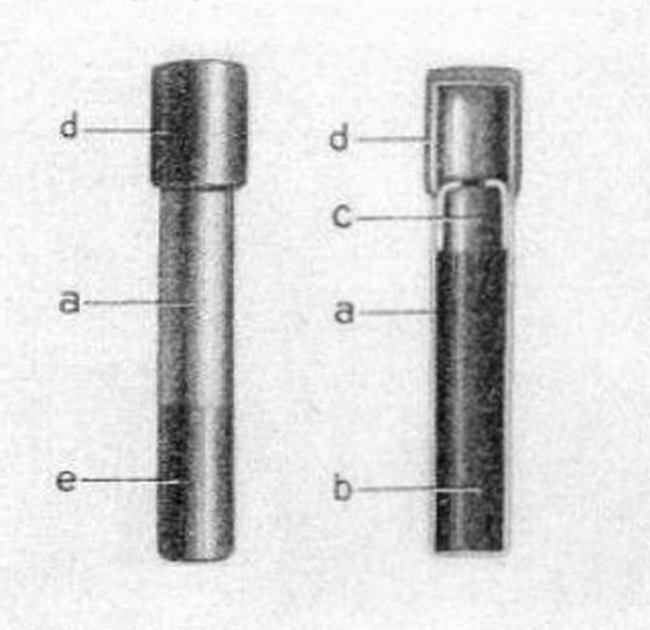 From H.Dv. 211/2. Cut-through
view
of the Zündladung N4 The
various smoke generators originally had their own
ignition charges. Zündladung N1 (white painted end) was used for
Nebelkerzen,
Zündladung N2 (black painted end) was used for Nebelkerzen S and
Nebelhandgranaten
and Zündladung N3 could be stored longer and was a substitute for N1
(color
code unknown). These three were all replaced by an order dated July 1,
1940.
This introduced the Einheits-Zündladung N4 (green painted end) as a
replacement
for all previous models. Probably the Zündladung N4 was taken into use
much
earlier than the official order indicates (as usual).
Box for Zündladung N4 Zündladung N4 was delivered in small cardboard boxes with either 12 or 15 pieces in each box. This was because the same cardboard box with the ignition charges were delivered respectively to the Nebelkerzen, which came in boxes of 12, or the Nebel hand grenade, which came in boxes of 15. The cardboard box with the ignition charges was packed in the same packaging as the igniters and the smoke grenades. Manufacturers and markings As
a
conclusion, I would therefore argue that the manufacturer of
Nebelhandgranate
39 was applied in white paint on the head, while the manufacturers who
have
marked handles and heads must be considered "subcontractors". Thus, it
seems very likely that many of these were delivered from the final
assembler
with a mix of subcontractor markings on heads and handles.
The
observant reader will see that the code
"enz" is really just an abbreviation for the manufacturer Enzesfelder
Metallwerke AG, Vienna. The cans and handles were
made by a number of the same makers that manufactured the
Stielhandgranate. But at least two examples have turned up made by a
hitherto unknown makers that did not manufacture any Stielhandgranate 24
parts.
The maker hidden behind the initials MS.M has not been identified yet.  (Picture courtesy of Ростислав, Russia) These Nebelhandgranate were purchased by the SS procurement office directly from a manufacturer that wasn't already manufacturing grenades for the Wehrmacht. The markings on these grenades appears to be handwritten in a sloppy way, but it is in fact a metal branding iron that applied the markings, as the irregularities are the same on all examples. The originality of these grenades is beyond doubt, they turn up in the same places that the newly formed SS-TV units were deployed. The handles have no traces of white painted rings, but the original dug-up examples have the smoke canister head still attached. But since these heads are often found in a very bad shape the handles are often mated with the heads from Stielhandgranaten, thus creating "fake" Stielhandgranaten. The handle is also marked with two WaA's, one above and one below the text. Heereswaffenamt code appears to be WaA 138. It is not known who filled the cans, as the condition of the observed cans is too bad. Thanks to Rostislav, Russia for the help with this identification. Another oddity! The maker of the handle is bpr, "Grossfuss, Johannes, Metall- u . Lackierwarenfabrik, Döbeln". That company was well known for their production of stamped parts for the MG34, and later MG42. No code is visible on the top of the can, it might be from the same manufacturer. Due to a fault in the stamping procedure it has a rim around the edge, making it look like it was assembled from two parts. This Nebelhandgrnate, which is all legit, is the only observed example from this manufacturer. Nebelhandgranate 39 was marked in a special way to enable the users to easily distinguish it from the Stielhandgranate 24. As previously mentioned, the handle had a 2 cm wide white band around the middle. If the worker had a bad day the result would be "inaccurate". The white paint markings on the head were applied using the same technique as used on the hand grenades. All markings on the side of the head were applied with a roller stamp leaving a pattern of micro dots. If the operator was accurate during the application, the marking formed a continuous circle around the head. Two examples of marking Nebelhandgranate 39. Note micro-dots and difference in font, as well as up-down text. There were obviously no strict rules for what was up or down, as a large proportion of the smoke grenades have the markings applied upside-down. The marking consisted of a 1cm high band that went around the entire head, but was divided into four equal lengths with a space between each section. This band is a common feature that is repeated on most smoke generators. Above this in large font, the type designation was applied. The type designation came in 5 main variants that seem to become more complex for each release.
The first four are variations on the same theme, while the last refers to changed mixing ratios in the smoke filling. In addition to the five variations of the text, the use of dots and different thickness of the font differs. Several versions of the markings found on the head. In H.Dv. 211/2 « Die Nebelmittel und ihre Handhabung. Die Nebelhandgranate» from August 25, 1939, variant 4 is already depicted, while some manufacturers still use the first variant well into 1940. Thus, there are no absolute transitions between the first four variants of the marking. Last variant, Nb.Hgr. 39 B, appears to be used from 1942 onwards. A closer study of the marking "Nb 39" reveals that this is an "arsenal variant". The marking "39" has been applied after the smoke grenades left the factory labeled "Nb".
On the opposite side of the type designation, the name of the manufacturer (before April 1940), or the code of the manufacturer, along with lot number / year was applied. This marking was rolled on in the same operation as the white band and designation. The lot number was also written in different ways, with and without the use of periods and slashes.
Of
course, some manufacturers always have to stand out, so the
manufacturer
cuq. used an oblong square around the factory code to be "unique".
They were also the only manufacturer to write the year before the lot
number,
and used all four digits (19XX). The code cuq. finally contained a
period, an
element that was added if there was a danger of confusion if the code
was
read upside-down. Interestingly, there was no danger of confusion in
the code
cuq and
they were not assigned the code with a period after. So this is an
element they
have added at their own expense. No rules without exceptions! Hagenuk (gqv) is the only one of these manufacturers that actually made their own cans.
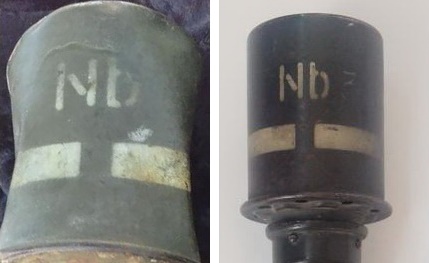 Two early cans marked "Hagenuk 1939" and "ЯR 784 1939". The first was filled by Hagenuk in 1939, the second in 1940. Hagenuk is also the only manufacturer of the Nebelhandgranate that used a stencil to apply the white marking. Note the broken lines of the "N" and "b". Also note the faint "39" arsenal re-mark on the right example. By 1941 Hagenuk marked their cans with the standard roller stamp like the rest. (Picture courtesy of Willi Z). 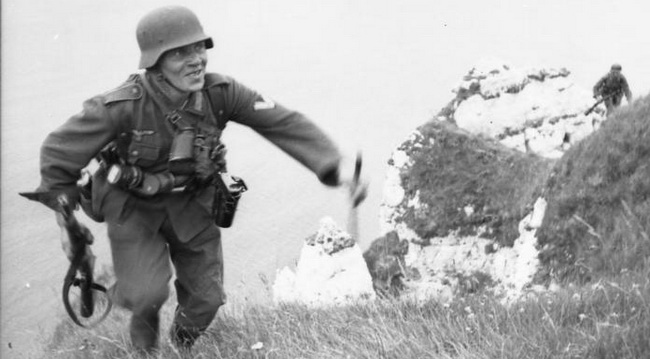 In addition, all Nebelhandgranaten had a piece of paper glued to the top, but not always with good results. Contemporary photos sometimes show smoke grenades with no paper tag present. The paper note was a printed warning: "Lebensgefahr beim Abbrennen in geschlossenen Räumen" (Life at risk if burned in confined spaces). This was because the fog that developed was highly hygroscopic (attracted water) and would lead to suffocation at higher concentrations.A
separate order
dated July 25, 1940 repeats this,
referring to an exercise in which life was lost. The paper note may
have a
slightly different appearance from manufacturer to manufacturer, but
NEVER have
typos.
Packing and transport
Due to
the danger
from fire during transport,
smoke grenades, igniters and igniter charges were packed separately,
but in the
same packaging. Standard packaging was the same metal case used for
Stielhandgranate 24, but with a 6 cm wide white band painted on to
signal that
it contained smoke grenades. The exterior and interior markings were of
course
also specific to the content.
The fire danger during shipment also resulted in the fact that the smoke grenades had to travel on the last class. They were classified together with other pyrotechnic materials, such as lighting and signaling agents. Should a fire occur, it would be desirable to keep all forms of pyrotechnic material separate from other ammunition. Both to limit the danger of spreading and to facilitate the extinguishing work. If sent by train, they should be loaded into the last carriage of the train, and there should be an empty carriage between this and other wagons with ammunition. When transported on a truck, it should not be loaded with other ammunition. When shipping by ship it should only be transported as a deck cargo. Other smoke generators As mentioned earlier, there were numerous uses of smoke within the Wehrmacht. The following other editions were used as "hand-held / hand-delivered" means of war, or replaced the Nebelhandgranate 39 entirely. 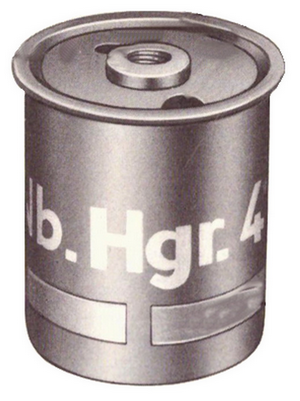 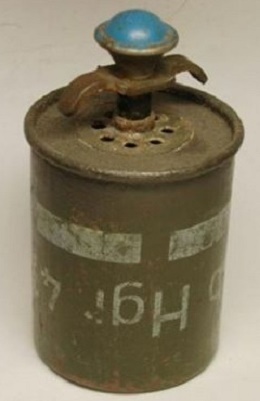 (Picture courtesy of Nick Jeans) -Nebelhandgranate 41. Very similar in shape and function to Nebelhandgranate 39 without handle. Weight 0.53 kg, burning time 1 ½ to 2 minutes. Marked in the same way as Nebelhandgranate 39, but with the text "Nb.Hgr. 41 ". This smoke grenade had a threaded portion in the ignition charge well and used the standard Zündladung N4 combined with a friction igniter without delay; Zündschnuranzünder 29 or 39. The grenade had either two large holes for the smoke, or a number of holes in a circular plate around the ignition charge well. The grenade was approved on October 6, 1941 for the same application as Nebelhandgranate 39. Packed 24 pieces in a wooden box. 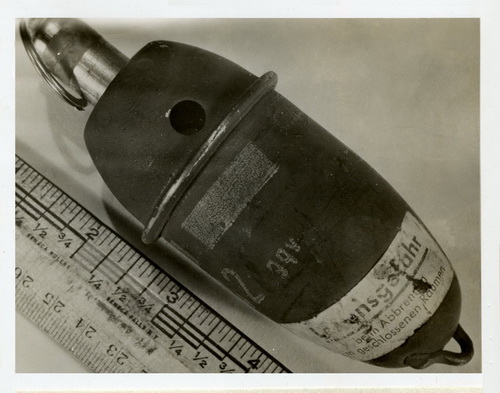 -Nebel-Eihandgranate 42. Egg-shaped smoke grenade with 3 gas holes at one end. Approved October 3, 1943. Marked in the same way as Nebelhandgranate 39, but with the text "Nb.Eihgr. 42 ". Contained 170 grams of smoking agent, total weight 280 grams. Used Zündladung N4 and a friction igniter without delay; Zündschnuranzünder 29. Low efficiency with burning time of 75 seconds, but had the advantage that it could be mounted on a stick for firing with flare gun (Wurfkörper 361) for precise delivery. 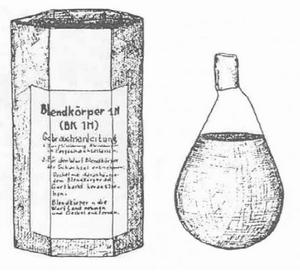 -Blendkörper 1 H (BK 1H). Hand grenade for fighting armor. Bulb liquid glass cylinder. The end is melted together and protected with plaster / cardboard. Filled with a mixture of Titanium tetrachloride and Silisium tetrachloride. Delivered ready-to-use packed in a cardboard box. No marking on the grenade itself. When the bulb was crushed, the active substances would react with the humidity in the air to produce smoke, and the quality of the smoke was entirely dependent on the humidity. Primarily used as an anti-glare agent to the front of tanks.  -Blendkörper 2 H (BK 2H). Hand grenade for fighting armor. Pear shaped glass cylinder with cork / plaster seal. Delivered ready to use packed in cardboard boxes with room for 4. No marking on the grenade itself. Filled with a mixture of Titanium tetrachloride and Silisium tetrachloride. A glass vial filled with calcium chloride was kept centered inside by the cork. The mixture reacted with the humidity in the air as the bulb was crushed to form a thick smoke. The calcium chloride vial increased the humidity and provided better smoke development while being frost-proof. The grenade could be used down to minus 40 degrees Celsius. Primarily used against the front of armored vehicles to dazzle the crew or in lucky cases force them to leave the tank. The first edition had a cork of plaster with grooves for better grip, later they got a screw cap from Bakelite. According to Panzernahkampfmittel from November 24, 1943 renamed from "2H BK" to "BK". Prohibition of practice on own armored vehicles due to danger of rust formation introduced on January 30, 1943. 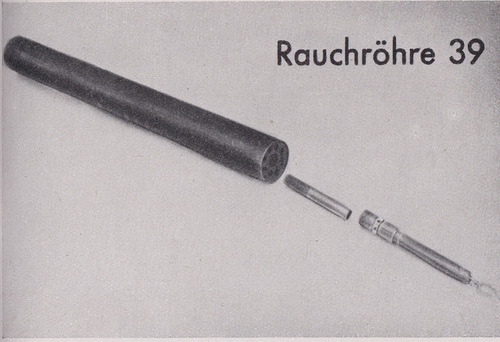 -Rauchröhre 39. Used by Pioneer companies mainly to fight bunkers. Cylindrical body of painted metal with well for ignition and friction igniter at the end, surrounded by holes for the generated smoke. Marked with "Nb.39" in blue on the side of the cylinder. Can be used as a regular smoke hand grenade, but due to its cylinder shape is very well suited to stick into smaller openings to “smoke out” the enemy. Burning time 90 seconds. Delivered in cardboard boxes of 10 pcs. Used standard Brennzünder 39 and Zündladung N4. This friction igniter had no handle or ring in the end, so the soldier must have been forced to improvise. It is also depicted without any such device in the manual. By order of O.K.H. dated September 12, 1940 it was prohibited to use other friction igniters, as these led to malfunctioning. 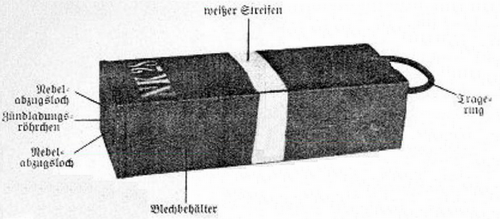 -Nebelkerze and Nebelkerze 28. Older versions of smoke boxes / charges. According to German Chemical Warfare Material, Chief Chemical officer, ETO, US Army. 1945, these were scrapped, but could still be found used for training during exercises. 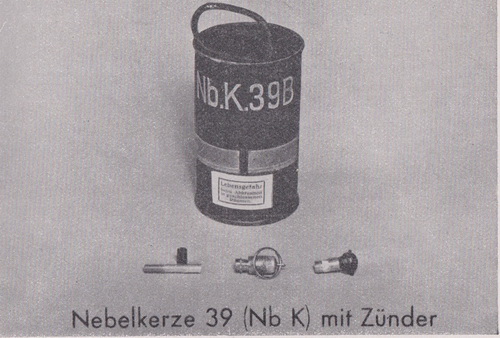 -Nebelkerze 39. Large smoke generator of 1.8 kg. Used mainly for self-screening. Marked in the same way as Nebelhandgranate 39, but with the text "Nb.K.39". Burning time 4 to 7 minutes. No delay on the igniter. Equipped with handle for deployment or handheld use in close combat with tanks. Used Zündladung N4 and Zündschnuranzünder 29 or 39. 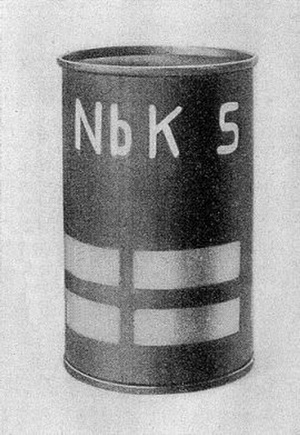 -Nebelkerze S. Confusingly very similar to Nebelkerze 39. Weight 1.7 kg. Marked in the same way, but with 2 white lines above each other and the text "Nb K S". Burning time 1 minute. Made for mechanical ejection from combat vehicles, enhanced with ejector charge in 1942 for better functionality. Used Zündschnuranzünder 29. The ring on the friction igniter was linked to the ejector with a small chain, so that ignition was initiated automatically. It gave an explosive smoke development as the container broke and scattered burning mass in a small area. Handheld use was prohibited. "Nebelkerze S" was renamed in August 1940 to "Schnellnebelkerze". 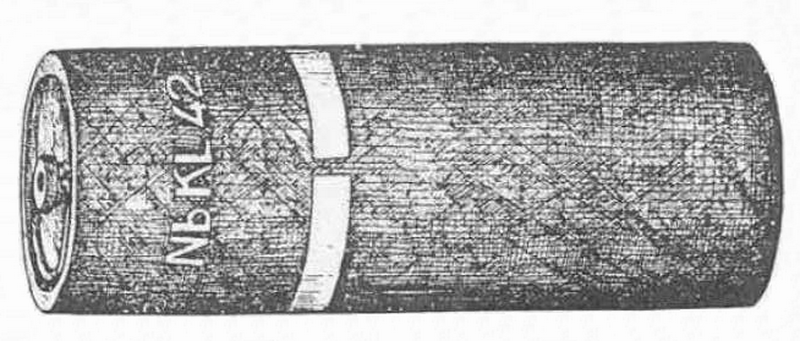 -Langnebelkerze 42 (NbK L 42). Used for larger smoke-laying operations. Burning time from 22 to 25 minutes, 48 cm high cylinder weighing 20 kg. Igniter was the Brennzünder 29 or 39, igniter charge was the "Zündladung Nebel 21". Same filler as the other Nebelkerzen. There was also a special edition of this designated NbK L 42 SZ. Weight 15.5 kg and burning time 15 minutes. This edition was filled with a mixture of Potassium Chlorate and Anthracite and produced a black smoke. 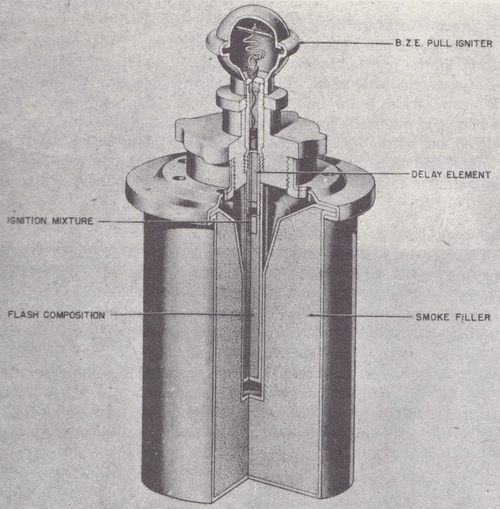 -Adapter for Nebelhandgranate 39. This was a plastic disc (Bakelite) which was threaded to mount on the head of Nebelhandgranate 39. It also had an internal thread hole over the center to mount a Zündschnuranzünder 29 or 39. I have not been able to find any German documentation or type designation from the war, but it appears in TM 9-1985-2 German Explosive Ordnance. 3/1953. The drawing is very inaccurate, so it is doubtful whether the artist had access to an actual example. It is not clear whether this was a separate model or whether the discs were produced due to a lack of handles in connection with the transition to Nebelhandgranate 41. Nebelhandgranate was in production from 1938. It officially changed its name to Nebelhandgranate 39 in 1939. In 1942 it came in a new edition with different mixing ratio (B). It looks as if production of Nebelhandgranate 39 B stopped around late 1942, early 1943. It was by then replaced in production by Nebelhandgranate 41 and Nebel Eihandgranate 42. Modern day copies Indeed, here as well! As the market for copies of the Stielhandgranate 24 is getting more and more profitable, even the Nebelhandgranate has been copied. Once again my thanks goes to Nick Jeans for his contribution. 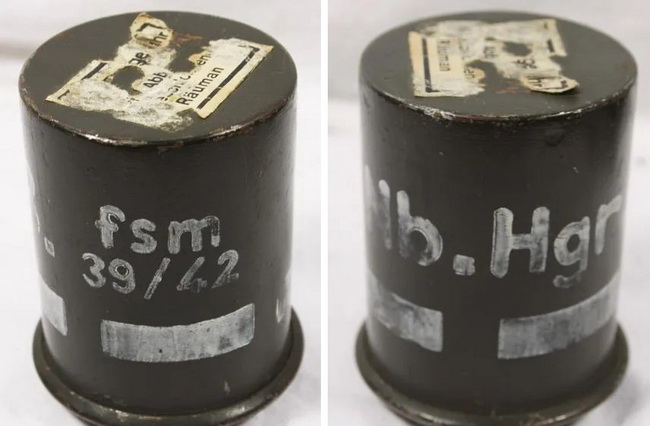 The one above might look convincing at first glance, but it falls short on several details that don't stand any scrutiny. The can has a much too sharp edge around the top, the paintwork of the marking is much too "rich" and white, totally missing the microdots. But worst of all, the misspelling on the label. They scratched away 90% of the text, leaving only one word readable.....that was misspelled. Compare with markings and labels above!  But the internals are even worse. Compare the first picture with the two fakes to the right. The internal cover plate is missing the dimples, the hole is much too small, they have drilled the holes all the way through the cover plate, the cover plate is much too thick, the threaded ring is much too thick and the shape of the cover plate is all wrong. Do your homework and you will not be fooled! |
| Home | For sale | Site map | Contact information | Guest book | Stielhandgranate 24 menu |